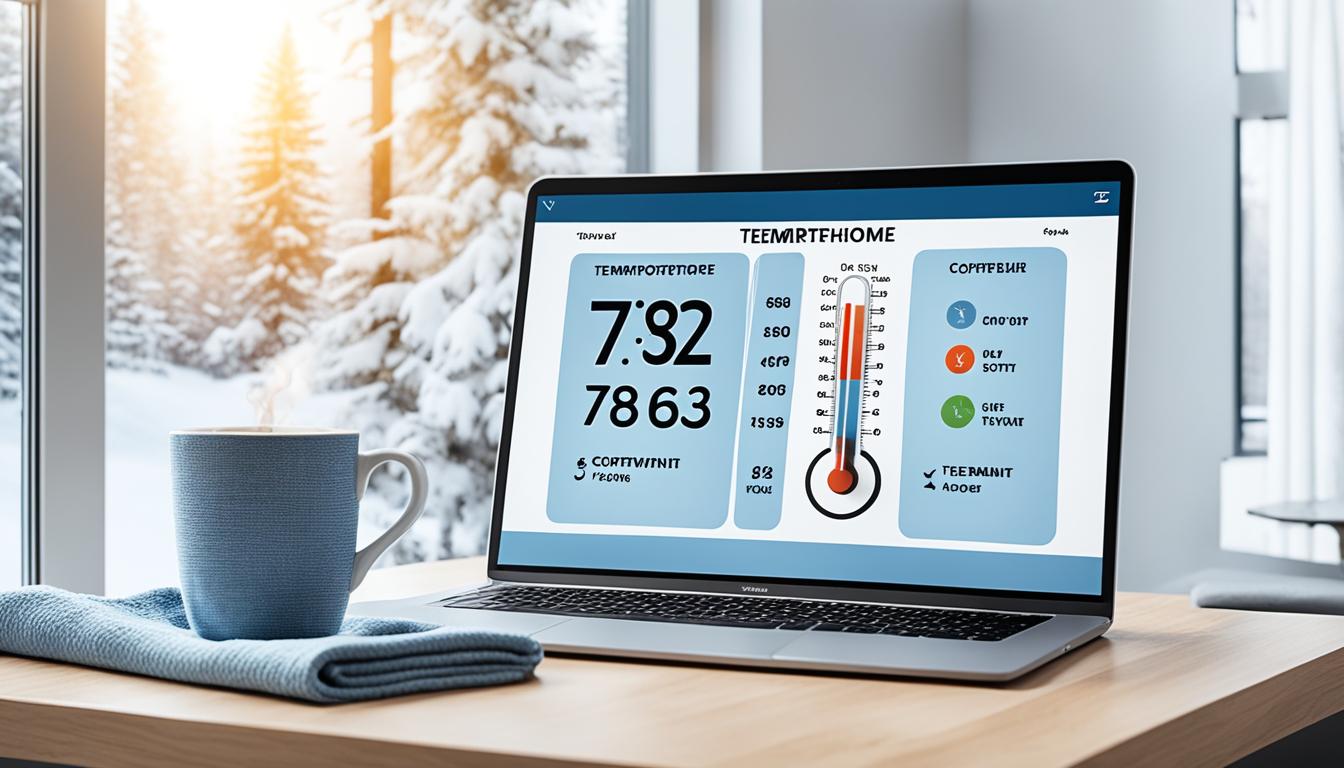More people are working from home, making us rethink the best temperatures for comfort and productivity. What’s the perfect temperature for a home office? You might be surprised1.
ASHRAE Standard 55-2013 recommends a summer temperature of 24.5°C, with a range of 23-26°C1. In winter, it suggests an ideal temperature of 22°C, with a range of 20-23.5°C1. But, these temperatures might not suit everyone, as they aim to please 80% of people1.
A study by the Helsinki University of Technology and Lawrence Berkeley National Laboratory found an interesting result2. Office workers were most productive at a temperature of 71-72 degrees Fahrenheit (21.7-22.2°C)2. This means the best temperature for a home office might be cooler than what ASHRAE recommends1.
The Impact of Office Temperature on Productivity
Recent studies show a strong link between office temperature and worker productivity. A Cornell University study found that at 68°F, workers made 25% more errors on keyboards3. But, at 77°F, errors fell to just 10%3. A University of Chicago study also showed that every degree above average temperature cut output by 3%3.
This means the temperature in the office greatly affects how well people work and think.
Recent Studies on Cognitive Performance and Temperature
Analysts looked at 24 studies and found the best temperature for work is about 71°F4. They also found that performance drops less than 10% by chance in temperatures below 59°F or above 89°F4. A study at the Insurance Office of America showed raising the temperature from 68 to 77°F cut typing errors by 44% and boosted output by 150%5.
But, the best temperature for work can change based on the job, climate, clothes, and personal comfort4. Some studies say feeling comfortable is more important than the exact temperature for work performance4.
A study by Helsinki University of Technology and Lawrence Berkeley National Laboratory found productivity peaks at about 71.6 degrees Fahrenheit5. Making the office more comfortable could save employers up to $2 per worker per hour, says Cornell University35.
Ideal Temperature for Work From Home Offices
Creating a comfy and productive work-from-home space is key. The U.S. Occupational Safety and Health Administration suggests a temperature of 68 to 76 degrees Fahrenheit6. This range keeps employees comfortable and boosts productivity.
Finding the right temperature is tricky. High humidity can make a room feel hotter, affecting focus6. Dry air can cause health problems like nosebleeds and breathing issues6. The ideal humidity for offices is 20 to 60 percent6.
Studies show a temperature of 72-76 degrees Fahrenheit keeps productivity up at home7. A cooler 72 degrees improves focus and alertness. Warmer temperatures can make you feel sleepy7. Try different temperatures to see what works best for you7.
Using programmable thermostats and fans helps keep your workspace comfy7. Keeping your HVAC system in good shape is also key, especially with the seasons changing7.
The perfect temperature for a home office balances comfort, productivity, and saving energy. Think about humidity, your comfort, and your HVAC system to make a great workspace678.
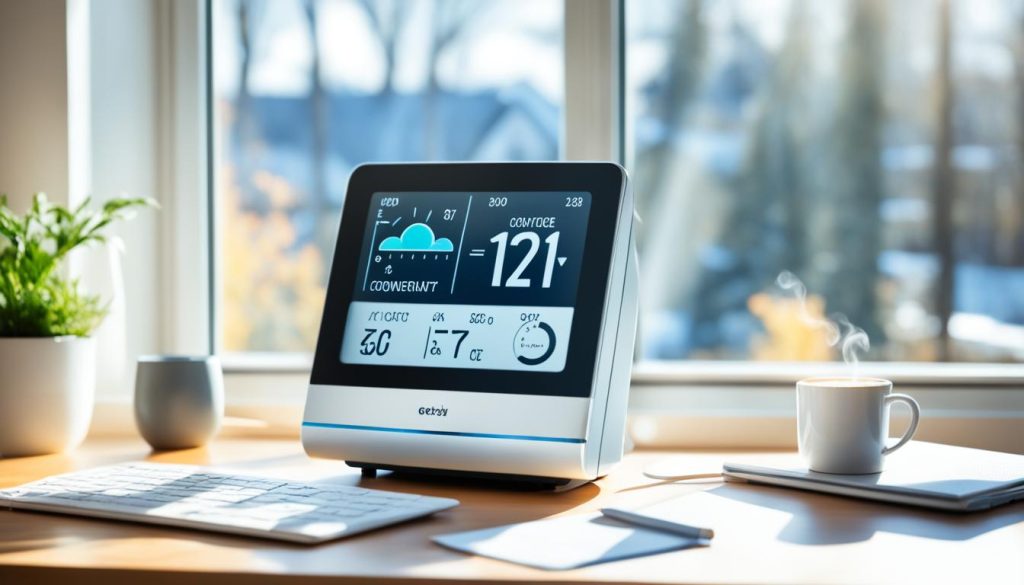
Why Women Prefer Warmer Temperatures
Studies show that women like warmer temperatures more than men in offices. This is because of the difference in how our bodies work. Women have less muscle and more fat, which means they don’t produce as much heat. So, they often feel colder than men in the same space9.
Metabolic Rates and Comfort Levels
Research says women want their offices about 3°C (5.4°F) warmer than men do10. A study in PLOS One showed that higher temperatures helped women do better on tests. Men’s scores went down as the temperature went up10.
This study found a strong link between temperature and how well women did on tests. Warmer temperatures meant better scores for women10. It shows we should think about the temperature needs of both men and women to make work comfortable and productive9.
Controlling the temperature at home can boost work performance9. Employers should aim for a temperature that suits both men and women. This makes the workplace more welcoming and productive for everyone910.
The Thermostat Battle: Men vs. Women
The “gender thermostat wars” have moved from offices to homes as more work from home. These battles over temperature can lead to tension and discomfort. A 2015 survey found that 42% of office workers feel it’s too warm, while 56% think it’s too11. Finding the perfect temperature for everyone is a big challenge.
Studies show women often have a lower metabolic rate than men and like their spaces about 3°C (5.4°F) warmer11. This can cause arguments over the thermostat, with one person feeling too cold and the other too warm. Women are more likely to argue over the temperature at home than12. Men often feel in charge of the heating and cooling.
It’s hard to find a middle ground on the temperature, especially when thermostat discussions end in a fight12. This can make it hard to adjust the temperature. Employers must check the temperature if 10% of staff complain. In places like Australia, workers can take breaks if it gets too hot11.
With personalized climate systems becoming more common, finding ways to solve the “thermostat battle” between men and women at home is key. This will help keep everyone productive and happy at home.
OSHA Recommended Office Temperature Range
The Occupational Safety and Health Administration (OSHA) sets guidelines for office temperatures13. They suggest keeping the thermostat between 68 and 78 degrees Fahrenheit13. This range aims to balance comfort and safety, preventing health issues like frostbite13 or hypothermia13 in cold weather, and heat-related illnesses13 in hot weather.
These OSHA guidelines are not laws but are still important for employers13. Employers should check temperatures and act if they’re too high or low13. They should use fans, air conditioning, and cool clothes in hot places, and warm clothes in cold places13.
Following OSHA’s office temperature guidelines helps employers make a good work space for remote workers13. This leads to better well-being and job satisfaction13.
Studies show how temperature affects thinking and work14. OSHA says keep the office at 68°F to 76°F14. Men like it at 72°F, and women at 77°F14. Knowing this, employers can make a work place that suits everyone14.
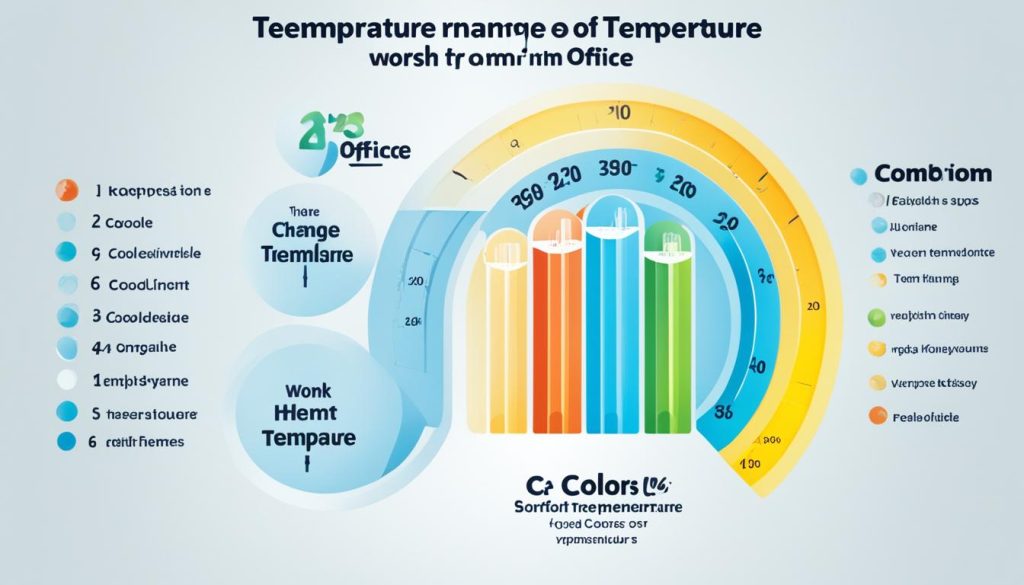
The OSHA recommended temperature range is a key guide for employers13. It helps make a good work environment for remote workers13. By focusing on comfort and well-being, employers can make a positive work culture. This leads to more productivity and happiness at work14.
| Employer | Preferred Office Temperature |
|---|---|
| Mark Zuckerberg | 59°F |
| Briggs Acquisitions | 65°F |
| SellMax | 69°F |
| United Capital Source | 73°F |
As more people work from home, keeping employees comfortable is key14. A balanced work environment leads to a positive culture. This makes people more productive and happy at work14.
Personalizing Home Office Climate Control
More people work from home now, making it key to control the climate in their work area. Smart thermostats and zonal heating/cooling systems let people set their own temperatures without affecting others at home. These tech solutions adjust temperatures precisely and learn what each person likes, making a space that boosts work and health15.
Smart Thermostats and Zonal Heating/Cooling
ASHRAE says office temperatures should be between 68°F and 74°F, with humidity at 30 to 60 percent15. A balanced climate in the office can cut energy costs by 10-30%15. Companies like Siemens aim to make offices more productive by changing temperatures as needed, creating a better work environment15.
Enlighted has created apps like Temperature Control that use AI to set temperatures based on what people prefer, changing offices for the better15. Numa offers a vent system for controlling the climate like airplane vents, making offices more comfortable and saving energy15. High-end HVAC systems also clean the air, making offices healthier15.
Smart HVAC systems and new tech are making workspaces better and more efficient, cutting energy use15. These smart systems and green practices balance comfort with saving energy, making workspaces more sustainable15. The future looks bright with offices that are comfy, save energy, and are good for the planet15.
| Feature | Benefit |
|---|---|
| Personalized temperature control | Maintains individual comfort levels without impacting others |
| Adaptive learning capabilities | Adjusts to user preferences over time for optimal comfort |
| Zonal heating/cooling | Provides targeted climate control for specific areas or workspaces |
| Energy-efficient design | Reduces energy consumption and operating costs |
| Advanced air filtration | Improves indoor air quality and workplace health |
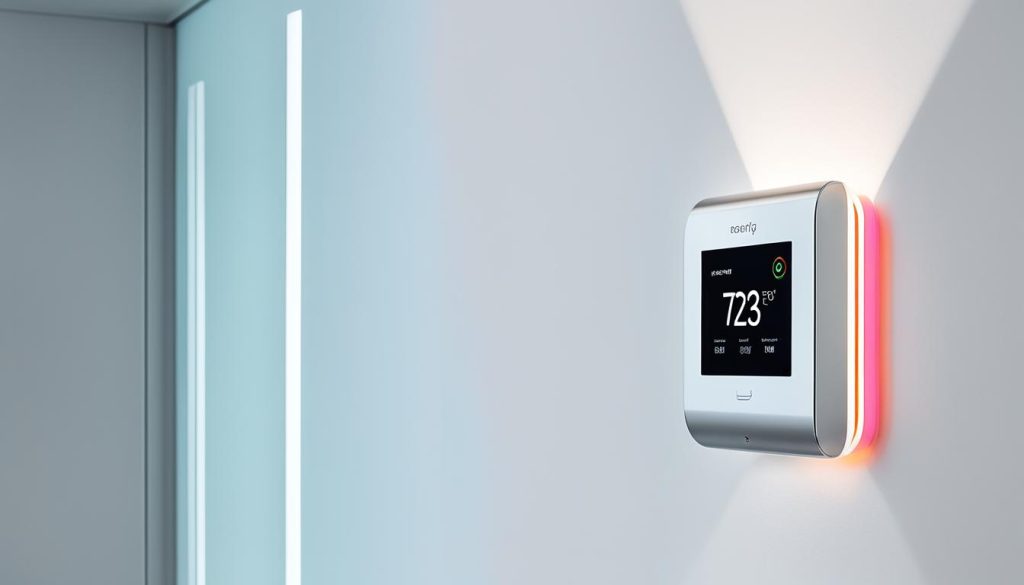
By using customizable home office temperature solutions and smart home technology, people can make a personalized workspace environment. This supports their unique needs and helps with zonal climate control and saving energy. The future of home office climate control looks bright, combining innovation, green practices, and comfort15.
Optimizing Energy Efficiency at Home
Keeping an energy-efficient home office is key for remote workers. It helps cut down on environmental harm and energy bills. With smart moves, you can save on temperature control energy savings and reduce home office energy costs without losing comfort or work efficiency.
Proper insulation is a big step towards better energy efficiency16. It keeps your office at a steady temperature. This eases the load on your HVAC system and lowers your energy bills.
Smart thermostats and zonal heating/cooling also help a lot17. They let you control the temperature in your work area only. This means you don’t heat or cool the whole house.
By using these energy-saving tips, remote workers can make their home offices comfy and efficient. They’ll also reduce home office energy costs and lessen their environmental footprint.
| Energy Efficiency Measure | Potential Energy Savings |
|---|---|
| Proper insulation | Up to 40% reduction in heat loss through the roof |
| Smart thermostats and zonal heating/cooling | Average of 30% on HVAC energy bills |
| LED lighting | Up to 80% savings on lighting costs |
| Dimmed lights and occupancy sensors | Up to 30% savings on lighting costs |
| Unplugging appliances on standby | Up to 50% reduction in energy use |
With these energy-saving steps, remote workers can make their energy-efficient home office comfy and productive. They’ll also reduce home office energy costs and lessen their environmental impact.
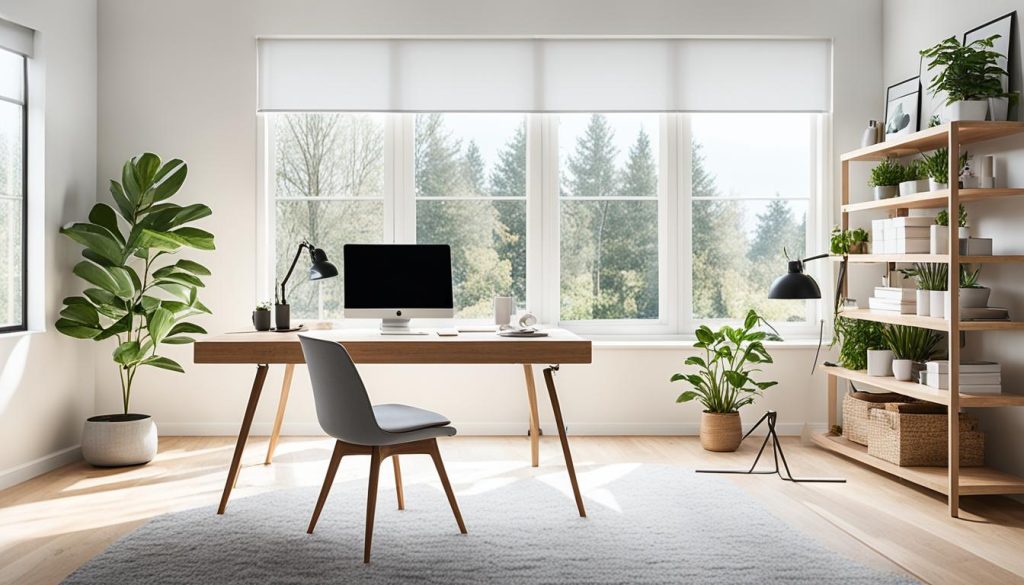
Employer Obligations for Remote Worker Comfort
As more people work from home, employers have new duties to keep their remote workers happy and healthy. This means helping with the cost of home office equipment and supplies like air conditioners and heaters18.
Helping remote workers set up their home offices can save money and boost productivity for companies. Research shows that the right temperature can make a big difference in how well people work1819.
Potential Cost Savings and Productivity Gains
- Remote work can lead to improved worker retention and higher productivity for organizations20.
- Companies that offer work-from-home options see less turnover, meaning they keep more employees19.
- Remote workers often work longer hours because they save time commuting and can start work early, making them more productive19.
- Work-from-home policies help reduce absenteeism by letting employees handle personal stuff while still working19.
- Offering work-from-home options can make life easier, reducing stress for employees19.
By taking care of employer responsibilities for remote workers, companies can make home offices better for everyone. This helps both the workers and the company18.
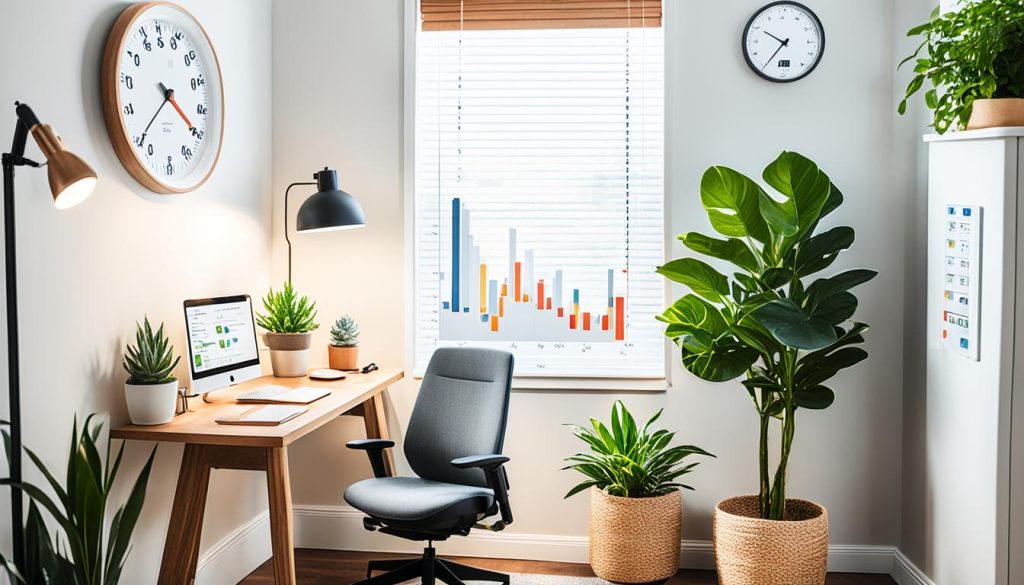
Employers need to make sure remote workspaces have good lighting, air flow, and the right temperature. They should also make sure there are no hazards, noise, or distractions18. Doing a risk assessment for computer use can prevent back and neck problems18.
Employers must take steps to fix any safety or health issues found in risk assessments for remote workers18. They should talk with employees about how to set up their workstations and listen to their needs to keep everyone safe18.
Psychological Factors in Temperature Perception
Psychological factors play a big role in how we feel about the temperature in our workspaces21. The kind of lighting, whether it’s warm or cool, can change how comfortable we feel, even if the temperature doesn’t change21. By choosing the right lighting and design for a home office, we can make it feel more comfortable and boost our productivity.
The temperature in offices greatly affects how well workers do their jobs, making up 38.56% of the performance impact21. The best temperature and lighting, at 21°C and 1000 lux, can make workers more productive and healthier21. Bad conditions in offices can make workers uncomfortable and unhappy, hurting their well-being21.
Performance drops by 2.4% for every degree the temperature goes up from 21.9°C to 28.5°C21. It falls by 5-7% if it gets over 25°C21. In cold at 10°C, performance drops by 13.91%, and in hot at 32.22°C, it drops by 14.88%21. Brighter lights make office workers do their tasks better, improving performance by more than 9%21.
How our body reacts to the temperature inside affects our health, comfort, and how well we work21. Good air quality and lighting help office workers in private offices do their jobs better21.
| Temperature Condition | Performance Impact |
|---|---|
| 10°C (Cold) | Decrease by 13.91% |
| 32.22°C (Hot) | Decrease by 14.88% |
| 21.9°C to 28.5°C | Decrease by 2.4% per degree |
| Above 25°C | Decrease by 5-7% |
A study with 35 male students showed how different temperatures affect their heart rate, brain functions, and speed22. High and low temperatures had big effects on these, more than moderate ones22. There were big differences in accuracy at different temperatures and workloads22.
High and low temperatures changed heart rate, brain functions, and breathing more than moderate ones22. High temperatures strain the heart to keep the body cool22. Performance drops 5% when temperature goes from 22.8°C to 30.6°C because of the heat22.
In summary, both physical and psychological factors, like lighting and temperature, greatly affect how we feel and work in our environments. Improving these can make remote workers more comfortable, happy, and productive.
Seasonal Adjustments for Home Office Temperatures
As seasons change, your home office’s ideal temperature may need to shift. In summer, keep your space cool to avoid heat. In winter, add heat to prevent it from getting too cold23. Adjusting your office’s climate all year can keep you focused and avoid the bad effects of extreme temperatures.
The ideal temperature for work is 68-76 degrees Fahrenheit, with humidity at 20%-60%23. In winter, aim for 68-70 degrees Fahrenheit. In summer, 72-74 degrees Fahrenheit is best23. Small changes in temperature can greatly improve your comfort and focus at work23.
Adjusting to seasonal changes in your office can boost your productivity and health24. Comfortable temperatures can cut typing errors by 50% and increase output by 150%, saving employers $2 per hour per worker24. A good office temperature can lift your spirits and make you more efficient, helping you and your employer.
Adjusting to seasonal changes in your office can greatly improve your work and well-being24. Comfortable temperatures can reduce typing mistakes by 50% and boost output by 150%, saving employers $2 per hour per worker24. Keeping your workspace at the right temperature can make you happier and more productive, helping everyone involved.
To keep your home office productive and comfy, watch and adjust the temperature as needed25. Using a smart thermostat or zonal systems makes it easy to keep the perfect temperature25. Also, pay attention to your comfort and make small changes, like wearing layers or using a fan or heater, to adjust to the seasons.
Health Benefits of Mild Temperature Variation
Keeping a steady temperature at home is key, but some studies say mild changes can be good for us26. Small changes in temperature can boost our metabolism and heart health, making us healthier27. This could be a smart way for remote workers to stay well.
Too much heat or cold can be bad for our health27. Too much heat can make us dizzy, faint, or even lead to serious heat stroke27. But, small changes in temperature can help our bodies in big ways, making us feel better overall2628.
Cooler temperatures can help us burn calories and keep our hearts healthy26. Warmer temperatures can make us sleep better and relax more26. By accepting these small changes, remote workers might get healthier and work better without feeling uncomfortable.
Finding the right temperature is key for each person26. By using smart temperature changes, remote workers can stay healthy and work well in a comfy space.
Collaborative Solutions for Shared Home Offices
Sharing a home office space can make finding the perfect temperature hard. Compromising temperature preferences and solving remote work temperature conflicts are key to a comfy and productive shared home office. Talking openly and finding solutions together can make the workspace better for everyone29.
To avoid temperature-related disputes in a shared office, using zone-based climate control helps a lot29. This lets each person set their own temperature, not just one for the whole space. Adding small heaters or fans can also help make sure everyone is comfy29.
- Collaborative communication to find a middle ground on the ideal temperature
- Implementing zonal heating and cooling systems for personalized climate control
- Strategically placing supplementary heating and cooling devices, such as space heaters and fans
- Incorporating design elements that promote privacy and concentration, like dividers29
Working together to solve shared home office temperature management issues, remote workers can make a space that’s good for everyone. This not only makes work better but also helps keep a good balance between work and life at home30.
The Role of Lighting in Perceived Temperature
Lighting greatly affects how we feel the temperature in a room, even if the actual temperature doesn’t change. Studies have shown that the kind of lighting can make a space feel warmer or cooler31.
Warm lighting, with red tones, makes us feel cozy and relaxed. Cool lighting, with blue tones, makes us feel cooler and more alert31. By picking the right lighting for your home office, you can change the feel of the room without changing the thermostat31.
Warm vs. Cool Lighting Effects
Warm lighting, like incandescent or halogen bulbs, makes us feel sleepy by increasing melatonin production31. Cool lighting, from LEDs or fluorescent bulbs, helps us concentrate and see better, but can make us stressed if used too much31.
The best lighting for work areas is similar to daylight, around 4,000K to 5,500K, to keep us alert and active32. Mixing warm and cool lighting, or changing it during the day, can make work more comfortable and productive32.
| Lighting Color Temperature | Recommended Use |
|---|---|
| 2700K – 3300K | Warm, inviting spaces like corridors or client meeting rooms |
| 4000K – 5500K | Vibrant, energetic workspaces and main office halls |
| 5000K | Office lobbies for a cool, formal ambiance |
Understanding how lighting affects temperature perception can make your home office more comfortable and productive313233.
Finding the right mix of warm and cool lighting is key to creating a space that meets your needs and tastes313233.
Encouraging Personal Thermal Comfort Strategies
Remote workers can use personal strategies to keep their workspace comfy. Keeping a sweater, blanket, or fan nearby lets you control your area34. If just tips aren’t enough, try relaxing the dress code, controlling the temperature, flexible hours, drinks, and more air34.
Using personal comfort steps helps meet each remote worker’s needs. Working in the cold can make it hard to move and work well35. On the other hand, too much heat can slow down movement and thinking, hurting work performance35.
Letting remote workers set their own temperatures can make them more productive and happy343536. This way, they can work better and feel good.
Source Links
- https://www.ccohs.ca/oshanswers/phys_agents/thermal_comfort.html
- https://www.danb.org/news-blog/detail/blog/finding-the-perfect-dental-office-temperature
- https://www.shrm.org/topics-tools/news/hot-cold-temperature-affects-productivity
- https://iaqscience.lbl.gov/temperature-and-office-work-performance
- https://www.kensington.com/news/ergonomic-workspace-blog/how-office-temperature-affects-productivity-and-state-of-well-being/
- https://buythermopro.com/ideal-temperature-and-humidity-for-office/
- https://www.aireserv.com/about/blog/2021/april/ideal-room-temperature-for-productivity-when-wor/
- https://www.autonomous.ai/ourblog/ideal-office-temperature-for-workplace
- https://www.steveglaveski.com/blog/what-is-the-optimal-home-office-temperature
- https://www.npr.org/2019/05/26/727108363/how-office-temperature-affects-cognitive-performance
- https://www.bbc.com/worklife/article/20160617-the-never-ending-battle-over-the-best-office-temperature
- https://www.inverse.com/article/60938-thermostat-conflict-men-women
- https://amtrustfinancial.com/blog/small-business/workplace-temperatures-laws
- https://www.businessnewsdaily.com/10964-office-temperature-debate.html
- https://www.metro-manhattan.com/blog/confronting-the-chill-managing-your-office-temperatures-during-colder-weather/
- https://www.pressac.com/insights/22-ways-to-save-energy-in-the-workplace/
- https://mysmartcocoon.com/blogs/blog/home-temperature-remote-work-importance
- https://www.hsa.ie/eng/topics/remote_working/remote_working_guidance.pdf
- https://www.vantagecircle.com/en/blog/work-from-home-policy/
- https://www.ccohs.ca/oshanswers/hsprograms/telework.html
- https://www.ncbi.nlm.nih.gov/pmc/articles/PMC4591743/
- https://www.ncbi.nlm.nih.gov/pmc/articles/PMC6377698/
- https://www.theseverngroup.com/ideal-office-thermostat-settings/
- https://www.cofmag.com/the-right-office-temperature-to-increase-productivity/
- https://www.corporatesuites.com/how-winter-impacts-your-office-productivity/
- https://cielowigle.com/blog/ideal-room-temperature/
- https://newsinhealth.nih.gov/2013/07/stay-cool
- https://www.workspacedesign.co.uk/gender-and-heating-in-the-workplace/
- https://www.extraspace.com/blog/home-organization/room-organization/shared-office-ideas/
- https://cmmonline.com/articles/5-ideas-for-designing-workspaces-that-inspire-collaboration
- https://buck.lighting/blog/the-effect-of-lighting-temperature-and-interior-colour-on-the-office-space-and-employees/
- https://www.superiorlighting.com/blog/the-ideal-led-color-temperature-for-the-office-space/
- https://www.benq.com/en-us/knowledge-center/knowledge/best-color-temperature-for-office.html
- https://www.cibse.org/knowledge-research/knowledge-portal/ctt8-cibse-top-tips-8-temperature-in-indoor-workplaces-thermal-comfort
- https://laminaheat.com/en/impact-of-heat-and-cold-on-employee-performance/
- https://www.mremergency.com.au/blog/home-office-room-temperature/

